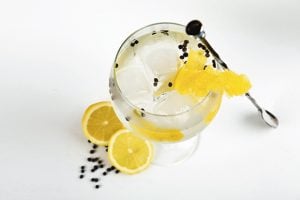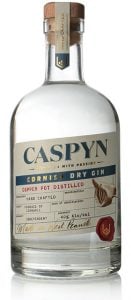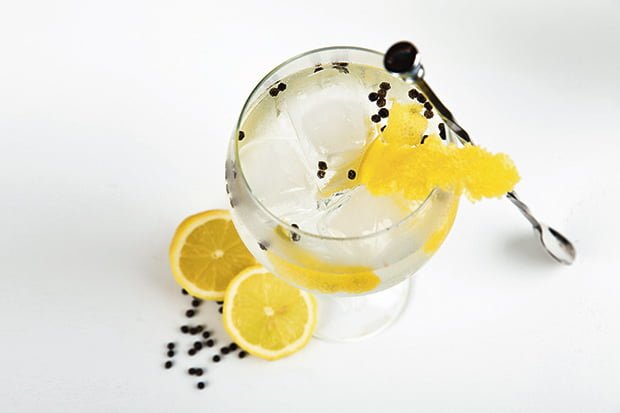“When life hands you lemons, make a gin and tonic.” – Anon
 We did toy with the idea of leading with the “Ginaissance”, but we thought that one had been done to the death! So “Gin-volution” it is.
We did toy with the idea of leading with the “Ginaissance”, but we thought that one had been done to the death! So “Gin-volution” it is.
The great news is that in recent years more bottles of the juniper-based drink have been sold than ever before. 2018 was a record year for gin sales with 66 million bottles of gin sold in 12 months, up 41% on the same period the year before and worth over £1.9 billion.
And to give the summer season a “gin-start”, World Gin Day takes place on June 8. The idea is simple: get people together with a legitimate excuse to drink some gin, whether it’s in a cocktail, G&T or neat. How hard can that be?
Much like fashion, there was a time when sales of gin were rather “fickle”. However, in the past few years, the spirit has been transformed from one made by a handful of large distillers to a category now represented by producers of all shapes and sizes. In key markets such as the UK, gin sales have rapidly grown!
Britain sends more gin around the world than it does beef or beer, with gin sales overseas worth 28% more than beer sales.
The USA remains the largest importer of UK gin, with sales to the US worth £191 million, up almost £13 million on 2017. Australia has also caught on to the British gin phenomenon spending £24.4 million on British gin, twice as much as they did in 2017 when they splashed out £12.2 million.
British Gin sales have also seen a surge in South Africa with £14.5 million sold last year, up from £4.5m in 2017 – a massive 222% increase.
Switzerland is another country where the popularity of British gin is rapidly rising and is now worth £6.6 million up from £4.8 million in 2017, growing by 38%.
By region, the EU is still by far the biggest destination for UK gin worth almost £290 million, with the European market up 14% on 2017.
Britain is currently the home to over 300 gin distillery’s which is twice as many as distillery’s operating in the UK five years ago.
According to the latest figures published by the Wine and Spirit Trade Association, sales of gin in the UK rose by 28% in volume and by 33% in value to reach £1.5 billion in the year ending 31 March 2018. This means that gin sales have more than doubled in value in five years (from £696m in the year ending March 2013). While the volume of gin sold has increased, this does not necessarily mean that the products themselves are completely new.
So what is making gin such a success? According to Andy Crossan, Consumer Insight Director at Kantar Worldpanel Alcovision, gin brands have succeeded in connecting with younger consumers: 4 years ago, 43% of 18-24s told us that they drink gin, it’s now 52%.
1.5m more UK adults are drinking gin than 4 years ago. So, what’s happened?
1. Premiumisation & positioning
There have been a number of factors that have conspired to make gin a more popular choice with consumers, with the origins being the acquisition of (and subsequent marketing investment in) Bombay Sapphire. It established the notion that there was something you could ‘trade up to’ in gin, says Matt Woodhams, Director at Kantar Consulting. ‘Gin was for the most part a standard category with no widely available mainstream premiumisation route. The beauty of the bottle, and the imagery and visual appeal around Bombay Sapphire, plus the marketing activation, gave it premium back bar appeal.’
With gin being comparatively easy to make, a multitude of ‘craft’ gin brands have sprung up, boasting both local credentials and unique flavour combinations that play into the premiumisation trend. It also gives gin the discernment credentials that craft beer has enjoyed, with the result that there are now 200 gin producers in Scotland alone, as well as hyper local brands made in small quantities.
The other new products that have sprung up to improve the gin-drinking experience are quality tonics. Historically, says Woodhams, the only spirits that tapped into the consumer desire to be discerning were Cognac and Whisky, and these would be drunk neat, over ice or with a dash of water. Their powerful flavour and the lack of a recognisable long serve with a discerning mixer limited the occasions where these products could play. But with the arrival of super premium mixers and the subsequent proliferation of tonic flavours, the opportunity for a discerning but refreshing and ‘personalised’ long drink choice using gin as a base opened up growth in a number of different drinking occasions untapped by traditional discerning spirits categories.
Today, 70% of gin serves are with tonic water, according to Kantar Worldpanel.
3. Customisation & experience
One of the things that helped Hendricks stand out was the custom serve highlighting its unique flavour profile (it’s served with cucumber rather than lime, generally). Woodhams claims this was the beginning of the idea of customisation and personalisation within the gin category, something that was happening in countries like Spain where the theatre of service – gin being poured at the table, into a large ‘copa’ glass filled with ice – was more common.
‘Not so long ago ordering a gin and tonic in the on-trade meant staff would turn around to service it from an optic. It would be in a small Paris Goblet wine glass, and you’d be asked if you wanted ice and lemon. Now, with gin often served in specific glassware, there is far more theatre to the pour, and the whole experience is far more visible, as many more on-trade outlets pour drinks at the bar.’
Again, the impact of quality mixer shouldn’t be underestimated. This, says Woodhams, has put gin in a new category and makes it suitable for more occasions. ‘A quality product, with quality mixers and theatre around the serve makes for a more interesting, exciting, acceptable, and suitable for different drinking occasions,’ says Woodhams.
Kantar Worldpanel Alcovision data shows that we drink gin on the same occasions as we would drink wine – for example with food.
4. Supply & choice
Gin is, comparatively, easy to make, hence the craft revival. You don’t have to age gin (unlike many other spirits categories) so the production is requires less capital and time. Moreover, the process of flavouring the spirit adds enough value to make this a profitable venture for those ready to get on with distilling – hence the roughly 200 companies distilling gin in Scotland, where the infrastructure and equipment already in place for whisky make this venture very appealing.
In the gin category, the amount of competition has actually been very beneficial. This choice for consumers leads to more visibility, and has also enhanced the idea that a consumer can customise the drink to their personal preferences. ‘Choice is a virtue of the category,’ says Woodhams. ‘It allows customers to be, or be seen to be, more discerning. Different bars and pubs will have a different serve for each gin so the customisation is also very visible, and the proliferation of mixer flavours creates an even bigger choice.’
Interestingly, while people enjoy this perception of choice, most people still choose standard gin and standard tonic – but there are lots of options to support that choice.
 According to Kantar Worldpanel, flavoured gin has been one of the biggest success stories in recent years. Pink Gin’s association with growing categories like spritzes and the light, refreshing aperitivo, as well as Prosecco cocktails, has helped to widen the gin category by expanding the occasions upon which gin is consumed and keeping it very much on trend. Over a quarter of all gin shoppers bought flavoured gin this year, compared to only 7% five years ago, testament to both the changing tastes of more adventurous consumers but also the influx of craftier gin products on the market. This has been driven by younger shoppers who are attracted by the sweeter taste, a trend reflected across categories as varied as fruit wines, flavoured vodka, and fruit cider.
According to Kantar Worldpanel, flavoured gin has been one of the biggest success stories in recent years. Pink Gin’s association with growing categories like spritzes and the light, refreshing aperitivo, as well as Prosecco cocktails, has helped to widen the gin category by expanding the occasions upon which gin is consumed and keeping it very much on trend. Over a quarter of all gin shoppers bought flavoured gin this year, compared to only 7% five years ago, testament to both the changing tastes of more adventurous consumers but also the influx of craftier gin products on the market. This has been driven by younger shoppers who are attracted by the sweeter taste, a trend reflected across categories as varied as fruit wines, flavoured vodka, and fruit cider.
5. New habits in drinking and socialising
According to Woodhams, the way we drink in the UK has changed, and this has made gin (and other spirits) more likely to be chosen than beer. ‘We spend less time in pubs, where the focus has always been on beer. As we opt for less high-tempo experiences (like nightclubs) and spend more time in mid-tempo environments, like casual dining venues, the drinks we are choosing are changing.’
Even in bars and pubs, gin and tonic is a good proposition where you just want one drink, but not beer or wine, or something fresh to kick off the evening. But generally, the drinking ‘Occasion’ has migrated to ‘Modern On-Trade’ – bars, casual dining, restaurants, and bars.
‘Younger people in particular are choosing to drink less but drink better, and as well as being more aware of the health impacts of consuming too much alcohol, they are socialising on social media and not in nightclubs. With an ageing population trend globally it is no surprise that fewer people are going clubbing. Society has shifted from pure hedonism as an attractive way to spend time,’ claims Woodhams. ‘Consumer, commercial, lifestyle, legislative, cultural and social factors are all combining to make us drink less but drink better.’ Kantar Worldpanel data supports this claim, says Crossan. ‘5.4m adults in Great Britain don’t drink alcohol at all now, up from 4m in 2013. 37.5% of under 35s believe that it’s worth paying extra in pubs, bars and restaurants – well above the average for all adults (29.6%). 18-24-year-olds in particular are those that are choosing to drink less, with the average number of alcoholic drinks they’re consuming in an average week falling from 13.5 to 12.4 over the last 4 years.’
 Andrew Richardson director of spirit drinks company VC2 Brands as a passionate advocate of smallbatch premium flavour gins and is seen a huge growth in this market ; “The Boe range of award winning gins sold outstandingly well in 2018, and are selling even better in 2019. From a standing start in 2017 Boe Violet Gin ended 2018 in over 11,000 pubs, and was listed by nearly all major wholesalers e.g. Matthew Clark, LWC, Carlsberg, HB Clarke, Nectar etc. The Boe range are proven successes in the on trade, and are one of the top 10 best selling gins in the likes of Fullers, LWC, Booker etc. There are many too many similar gins in the market now, but we pride ourselves on bringing new flavours to gin, and to developing distinctive, premium gins which sell. Boe Passion Gin has just been launched and is showing every indication of being as popular as Boe Violet Gin.”
Andrew Richardson director of spirit drinks company VC2 Brands as a passionate advocate of smallbatch premium flavour gins and is seen a huge growth in this market ; “The Boe range of award winning gins sold outstandingly well in 2018, and are selling even better in 2019. From a standing start in 2017 Boe Violet Gin ended 2018 in over 11,000 pubs, and was listed by nearly all major wholesalers e.g. Matthew Clark, LWC, Carlsberg, HB Clarke, Nectar etc. The Boe range are proven successes in the on trade, and are one of the top 10 best selling gins in the likes of Fullers, LWC, Booker etc. There are many too many similar gins in the market now, but we pride ourselves on bringing new flavours to gin, and to developing distinctive, premium gins which sell. Boe Passion Gin has just been launched and is showing every indication of being as popular as Boe Violet Gin.”
 Capitalising on the country’s growing appetite and interest in gin Nelson’s Distillery & School Founder Neil Harrison has seen a huge uplift in bookings for courses at his gin school. Nelson’s Timur Gin, the first in the world to commercially use the Timur pepper ingredient, recently picked up the prestigious prize in the gin category, the largest category in the competition by far, with over 330 entries.
Capitalising on the country’s growing appetite and interest in gin Nelson’s Distillery & School Founder Neil Harrison has seen a huge uplift in bookings for courses at his gin school. Nelson’s Timur Gin, the first in the world to commercially use the Timur pepper ingredient, recently picked up the prestigious prize in the gin category, the largest category in the competition by far, with over 330 entries.
Nelson’s Distillery & School is the 2016 creation of Neil Harrison, who developed the award-winning Timur gin recipe in 2018. Speaking about his award-winning gin, master distiller Harrison said “we are extremely proud of this spirit. Using the Timur pepper which is grown and consciously sourced in Nepal, we have created a world’s first and only gin with wonderful zesty citrus flavours and a sharp, spicy aroma”.
The distillery produces six varieties of gin and two varieties of rum which are distributed globally as well as through UK stockists including Waitrose, Harrods, Majestic Wine plus many independents.
 Shaun Bebington, founder of craft distillery Pocketful of Stones is a firm believer of ‘use seasonal serve local’! Pocketfull of Stones was born in the cellar of a pub in London he said. “Sat around a tiny copper still, me and my brother Dale tinkered with gin recipe after gin recipe. Our dream was to get back to our roots, the outdoors and the ocean and produce something we are both passionate about, and Caspyn was born.”
Shaun Bebington, founder of craft distillery Pocketful of Stones is a firm believer of ‘use seasonal serve local’! Pocketfull of Stones was born in the cellar of a pub in London he said. “Sat around a tiny copper still, me and my brother Dale tinkered with gin recipe after gin recipe. Our dream was to get back to our roots, the outdoors and the ocean and produce something we are both passionate about, and Caspyn was born.”
“Caspyn Cornish Dry gin has taken inspiration from our surroundings, the rolling green hills of Cornwall and the crystal clear waters of the Atlantic. I like to compare it to those early Cornish spring mornings. When it’s still a wee bit cold, the sea is that crystal clear blue but you know it’s still too cold to jump in to. You’re probably wrapped up, but you feel warm and it’s crisp, invigorating. You know those mornings.”
Caspyn Cornish Dry is supported by their Cucumber and Dill infused Caspyn Midsummer Gin and Caspyn Summer Cup. All made with fresh in season Cornish produce. Pocketful of Stones be releasing a few new varieties this year including a Squid Inc Gin, a Dandelion and Burdock Gin and a Marmalde Old Tom. Watch this space. d Burdock Gin and a Marmalde Old Tom. Watch this space.rdock Gin and a Marmalde Old Tom. Watch this space.”!
“MY FRUIT SALAD RECIPE INVOLVES A LIME TOSSED WITH SOME GIN AND TONIC”.
Tips for Gin Lovers!
1. Tasting gin
To sample a gin like a professional pour just a small measure into a clean wine glass and swirl to release the aroma. Then sip a little bit neat, nowadays, a lot more gins are designed to be drunk neat, and its much easier to find a gin that might feature flavors you prefer, whether you like cinnamon or cardamom, citrus or floral notes. Now add twice as much tonic to the gin – or water if you prefer – and try it again to see how the gin tastes when ‘cut’.
2. Garnishes
These can be wide and mixed but be aware that very strong flavours in a garnish might overpower the subtle tones of your top-quality gin. Garnishes don’t have to be lemon or lime, either. Pink grapefruit is very much the garnish of the moment – either a wedge, slice or twist of zest – and a slice of apple is popular too.
More unusual garnishes comprise of bay or sage leaves, sprigs of thyme, mint, basil or tarragon, all sorts of fresh berries, thin sticks of young rhubarb, rock salt, fresh ginger slices and a tiny piece of chilli.
Twist citrus fruit to release the juice and oils and bruise the garnish or rub it on the edge of the glass to make it stronger.
3. Carefully crafted mixers
Equally important will be your choice of mixer, you won’t want to offer Artisan gins any old mixer! Consumers are always looking for choice with research revealing that 63% of people drink more than one mixer brand . Quality mixers are big sellers!
4. Serving gin
There’s nothing wrong with a gin and tonic in a tumbler but better is a copa glass. This wide-bowled glass (rather like a large wine glass), with its long stem is a favourite for gin as it holds a lot of ice. A contemporary version that’s become popular is the stemless copa.
5. Food matching
It’s a myth that gin doesn’t go with food. Just try sipping neat cold gin or a G&T with salty-savoury snacks like olives, spreads and dips such as tapenade, aioli and anchoiade. It’s also great with peppery salad leaves, and smoked, cured or ceviche fish and seafood.
6. Storing
Keep your opened gin bottles out of bright light and in a cool place. Even unopened bottles should be kept away from direct sources of heat.
www.indiebrands.co.uk
www.pocketfulofstones.com
www.nelsonsdistillery.co.uk
www.inginius.com
www.boegin.com
www.greensanddistillery.com


